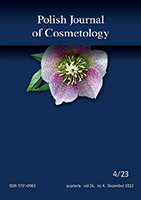search by
Copyright @ Pol J CosmetolContemporary methods used in a beauty salon for acne skin careMarian M. Zgoda 1/, Andrzej Stańczak 4/, Agnieszka Żarek 1/, Justyna Kołodziejska 2/, Sławomira Nowak 3/, Katarzyna Bujnicka 1/, Zbigniew Marczyński 4/ 1/ Wyższa Szkoła Kosmetyki i Nauk o Zdrowiu w Łodzi 2/ Pracownia Kosmetyki Farmaceutycznej, Zakład Technologii Postaci Leku, Katedra Farmacji Stosowanej, Uniwersytet Medyczny w Łodzi 3/ Katedra i Zakład Farmakognozji, Uniwersytet Medyczny w Łodzi 4/ Zakład Farmacji Aptecznej, Katedry Farmacji Stosowanej, Uniwersytet Medyczny w Łodzi Summary Introduction. The original range of products of the cosmetics industry based primarily on real solutions of α- and β-hydroxy acids or their physicochemical mixture and above all problems with the optimal application of the preparation in the cosmetologist´s office were the reason for undertaking research on the mass exchange profile across the phase boundary (preparation/skin) during chemical peeling. Aim. The aim was calculation of the diffusion coefficient for α- and β-hydroxy acids, bioavailability of which = 1,0. The diffusion coefficient is a physicochemical value which, under the conditions of dermal exposure of preparations determines their effectiveness (dermabrassion) in the treatment of acne. Material and methods. Preparations for professional peeling were the research material. There were tested preparations containing lactic, mandelic, azelaic, salicylic, citric and tartaric acids in a solution with appropriate viscosity and pH. Results. The α- and β-hydroxy acid structures were characterized by basic thermodynamic values, which allowed calculating the radius of the diffusing particle. Practical viscosity of the preparation determined by Casson mathematical model was the basis for estimating the diffusion coefficient in the equilibrium system. Low viscosity of the preparations ensures their high flow, which determines the degree of skin coverage and ensures endo- and diadermal effect of the tested preparations without participation of the transdermal transition promoter. Conclusions. The results of the viscosity tests and the calculated thermodynamic quantities that characterized the preparations used in beauty salons in chemical surface dermabrasion confirm their high treatment efficacy and safety of use in anti-acne treatment carried out by a qualified cosmetologist. Key words: surface chemical peeling, dermabrasion, yield stress, acne |




